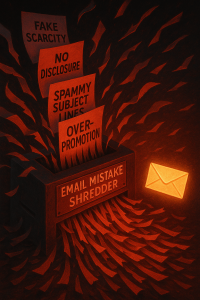Want to know how to write affiliate emails that don’t get deleted, ignored, or sent straight to spam?
Here’s the secret most marketers miss:
The emails that sell best don’t feel like affiliate emails.
They feel like a smart friend saying, “Hey, I tried this… it actually helped. You might like it too.”
In this post, you’ll learn exactly how to write affiliate emails that:
- Build trust (so people want to hear from you)
- Promote offers without sounding desperate or salesy
- Get opened, read, and clicked — without spammy tricks
Affiliate email writing is the process of sending conversational, trust-based emails that recommend products you genuinely believe in… rather than pushing aggressive promotions. These emails focus on helping the reader, sharing real experiences, and offering a solution that feels natural, personal, and useful… not salesy.
We’ll walk through frameworks, examples, templates, and a step-by-step process you can use for every promotion you ever send.
Why Most Affiliate Emails Fail (And What to Do Instead)
 Think about the last awful affiliate email you saw.
Think about the last awful affiliate email you saw.
It probably looked like this:
- SHOUTY SUBJECT LINE WITH 🔥🔥🔥
- Over-the-top claims (“BEST THING EVER!!!”)
- Fake urgency (“ONLY 17 SPOTS LEFT!!!”)
- Link spam everywhere
Those emails fail for three big reasons:
1. They try to “convince” instead of recommend
The mindset is: “How do I get this person to buy so I can earn a commission?”
Your subscribers can feel that. They feel like walking wallets… not people.
Promoting = pushing for a commission.
Recommending = sharing something genuinely useful (and yes, you earn if they buy).
2. They pitch too early
Most people treat their email list like a vending machine:
- Vanish for weeks
- Pop back up only when they have something to sell
- Hammer subscribers with 3–5 promo emails in a row
But the sale doesn’t happen in the promotion email… it happens in the 10 value emails you sent beforehand.
3. They ignore the 80/20 rule
The best-performing affiliate email strategies keep a rough 80/20 ratio:
- 80% value emails (teaching, stories, insights, resources)
- 20% promo emails (where you actually push an offer)
If you only show up when you want a sale, you’re the stranger shouting in the street.
If you show up consistently with value, you become the trusted friend.
The Trusted-Friend Framework for Writing Affiliate Emails
 Before we talk about subject lines and CTAs, we need one simple framework:
Before we talk about subject lines and CTAs, we need one simple framework:
1. Recommend like a friend, not like a salesman
Ask yourself before every promotion:
“Would I recommend this to a friend, even if there was no commission involved?”
If the answer is no, don’t send the email. Your reputation is worth more than a one-off payout.
2. 80/20: Value first, promotion second
Make this your default rhythm:
- 4–5 value emails
- Then 1 promotional sequence (3–7 emails)
Value emails can be:
- Quick tips & tutorials
- Stories + lessons learned
- Industry insights
- Resources that don’t have your affiliate link
Ever notice your advice hits harder when you’re not constantly giving it?
Same with recommendations… If you only suggest stuff when it actually matters, people lean in instead of tuning out.
3. Set clear rules for what you’ll promote
Steal this filter:
- Have I used it, or do I know someone credible who has?
- Is the sales page honest (no fake countdowns, no ridiculous income claims)?
- Is the price fair for what it delivers?
- Is there a refund policy?
If it fails the filter → no email.
Step-by-Step: How to Write an Affiliate Email (From Blank Screen to Send)
 This is the part most articles hand-wave. Let’s get practical.
This is the part most articles hand-wave. Let’s get practical.
Step 1: Choose one person and one problem
Before you write a word, answer:
- Who exactly am I talking to? (newbie blogger, freelance designer, busy parent…)
- What painful problem are they dealing with right now?
Example:
“I’m talking to a beginner affiliate marketer who’s overwhelmed by tech and wants an easy way to build funnels.”
That clarity makes your email feel like a personal note, not a broadcast.
Step 2: Write a curiosity-driven subject line (no spammy tricks)
Your subject line has one job: get the open.
Good affiliate email subject lines tend to be:
- Short (under ~50 characters)
- Conversational (like something you’d text a friend)
- Curiosity-driven or benefit-driven
- Honest (no bait-and-switch)
Examples you can adapt:
- the tool I was wrong about
- I almost didn’t send this
- struggling with [problem]?
- this fixed my [pain] in a week
Avoid:
- ALL CAPS
- Emoji overload
- “FREE!!!” / “ACT NOW!!!” (spam filters love those… in a bad way)
Step 3: Hook them in the first 2–3 lines
Your email has about 2 seconds to prove it’s not boring, spammy, or written by a robot.
Those first lines? That’s your audition tape.
Strong opening options:
- Story hook:
“For two years, I ignored this tool.” - Problem hook:
“You ever spend three hours writing an email… and get zero clicks?” - Confession:
“I used to write affiliate emails I’d be embarrassed to show you.”
What NOT to do:
- Start with “I hope this email finds you well”
- Ramble about your weekend
- Lead with a feature list
Step 4: Build the bridge from problem → solution
Once you’ve hooked them, show you get their situation.
Example “bridge” copy:
“You sit down to write, and suddenly it’s 90 minutes later and you’ve got a half-finished email and a headache. That was me for years… until I changed how I write affiliate emails.”
This sets you up to introduce how you solved it… and later, the product.
Step 5: Introduce the product like a recommendation, not a pitch
 Here’s a simple structure:
Here’s a simple structure:
- What it is (in 1–2 plain-English sentences)
- What it did for you (specific result)
- Who it’s for / not for
Example:
“A month ago I switched to [Tool Name] to handle my funnels.
I went from manually duct-taping pages and emails together to setting everything up in one weekend — and then just tweaking. If you’re brand new or allergic to tech, this is the first tool I’d look at. If you’re already happy with your stack, skip it.”
Notice:
- No hype
- Clear benefit
- It’s okay if it’s not for everyone (this builds trust).
Step 6: Add a clear, low-pressure call to action
A lot of otherwise good affiliate emails fizzle here.
Make your CTA:
- Crystal clear (“Click here to see how it works”)
- Singular (one main action)
- Low-pressure (“might be worth a look”)
Examples:
- “Here’s the link if you want to check it out: [LINK].”
- “Go watch the free training here: [LINK].”
- “If this sounds like something you need, you can see everything it does here: [LINK].”
One link in the body, one near the end, maybe one in the P.S. — you don’t need 10.
Step 7: Add disclosure and make it legally clean
Good news: disclosure doesn’t kill conversions… it builds credibility and keeps you out of trouble.
Simple options:
- In the body:
“Heads up: that’s an affiliate link. If you grab it, I’ll earn a small commission (no extra cost to you).” - In the P.S.:
“P.S. That’s my affiliate link… I’ll earn a commission if you buy. I only recommend stuff I genuinely think will help.”
Also make sure you:
- Include an unsubscribe link in every email
- Honesty-check any urgency or scarcity (no fake timers)
Plug-and-Play Affiliate Email Template (With Commentary)
Here’s a simple “personal review” email you can adapt for almost any offer.
Subject: the tool I was wrong about
Email:
For two years, I ignored [Tool Name].
People kept recommending it and I kept saying, “I don’t need another subscription.”
Then last month I finally tried it.
Within a week, I cancelled two other tools I’d been paying for.
Here’s what changed:
- [Specific result #1]
- [Specific result #2]
- [Specific result #3]
Is it perfect? No. [One honest drawback – this builds trust.]
But for [specific task], nothing else I’ve tried comes close.
If you’re struggling with [problem], it might be worth a look: [LINK]
– [Your Name]
P.S. That’s my affiliate link, which means I’ll earn a small commission if you sign up. Doesn’t cost you anything extra… I just want you to know.
You can reuse this structure again and again:
Story → Resistance → Try → Result → Pros/cons → Soft CTA → Honest disclosure
Real-World Affiliate Email Styles (And When to Use Each)
 You don’t need 50 different templates. You need a few original emails you can reuse.
You don’t need 50 different templates. You need a few original emails you can reuse.
1. Problem → Solution email (great for beginners)
Use when: your audience is actively struggling with a clear pain.
Structure:
- Call out the problem
- Agitate it (what happens if they don’t fix it)
- Introduce the solution
- Show how the product fits that solution
- Invite them to check it out
Example skeleton:
Subject: struggling with [problem]?
You ever [describe frustrating situation]?
It’s exhausting because [agitate the pain].
I tried doing it the hard way for [timeframe]. Didn’t work.
What finally worked was [explain solution briefly].
The tool/course I’m using now is [Product Name]. It helps you:
- [Benefit 1]
- [Benefit 2]
- [Benefit 3]
If [problem] is eating your time, this might be worth a look: [LINK].
2. “Still thinking?” follow-up (for fence-sitters)
Use when: someone has clicked but hasn’t bought.
Structure (short and conversational):
Subject: still thinking about it?
Hey,
I noticed you checked out [Product Name] but didn’t grab it (totally fine).
If you’re on the fence, what’s holding you back?
- Not sure if it’ll fit your situation?
- Worried about the time commitment?
- Unsure if it’s worth the price?
Hit reply and tell me… I’m happy to give you my honest take.
If you missed the details, here’s the link again: [LINK]
This kind of email:
- Feels human
- Respects their decision
- Often pulls in extra sales from people who just needed clarity
3. Value-first story email (warm-up before a promo)
Use when: you’re about to promote a related product.
Structure:
- Tell a short story about a mistake or win
- Share the lesson (value)
- Softly hint that you’ll share a tool or training soon
If you only pop into someone’s inbox when you’re selling something, it’s not a relationship… it’s a popup ad with feelings.
Turning One Email Into a Simple Affiliate Email Sequence
 Most of the winning content on page 1 emphasizes sequences, not single blasts.
Most of the winning content on page 1 emphasizes sequences, not single blasts.
Here’s a simple 5-email sequence you can adapt:
Email 1 – Problem & story (no pitch)
- Subject: “I almost quit last year”
- Talk about the problem your audience has.
- Share your story.
- No links, no pitch.
Email 2 – Education & insight (value only)
- Subject: “3 mistakes I kept making with [topic]”
- Teach them something useful.
- Maybe mention a concept the product helps with… but no links yet.
Email 3 – Personal review email (soft pitch)
- Subject: “the tool I was wrong about”
- Use the Personal Review template.
- 1–2 links.
Email 4 – FAQ/objections
- Subject: “[Product] – your questions answered”
- Answer common questions (time, price, experience level, refund policy, etc.).
Email 5 – Last chance / decision
- Subject: “closing tonight” (only if there’s real urgency)
- Short reminder, clear CTA, mention bonus or deadline.
This sequence mirrors what the top guides recommend (build trust, educate, then promote with real urgency) while going deeper into how to write each email.
Common Mistakes to Avoid When Writing Affiliate Emails
 Even if your copy is solid, these mistakes can quietly kill your results:
Even if your copy is solid, these mistakes can quietly kill your results:
1. Writing like a commercial, not a person
If your email sounds like a sales page glued into Gmail, people bail.
Fix it:
- Use simple language
- Write in first person
- Read it out loud — if you wouldn’t say it to a friend, rewrite it
2. Fake urgency and scarcity
“Closes tonight!” …and it’s still open next week.
People remember that. You don’t just lose a sale… you lose trust.
Use urgency only when:
- The price really goes up
- A bonus actually expires
- The cart actually closes
3. Over-promising and under-delivering
Never imply guaranteed income, overnight success, or “push-button” results.
Instead:
- Be honest about effort required
- Frame the product as a tool, not a magic pill
4. Link stuffing
More links ≠ more clicks.
Too many links:
- Look desperate
- Trigger spam filters
- Confuse readers about what to do next
Stick to:
- 1 link in the middle
- 1 near the end
- Optional 1 in the P.S.
5. Skipping segmentation and sending the same email to everyone
Top email guides emphasize segmentation and relevance… affiliate emails convert better when they’re targeted.
Segment by:
- Interest tags (SEO, funnels, AI tools, etc.)
- Past purchases
- Click behavior (who clicked what)
Then tweak your angle for each group.
FAQ: How to Write Affiliate Emails (Fast Answers)
 1. How long should an affiliate email be?
1. How long should an affiliate email be?
Short enough to be read in under 2–3 minutes.
- Simple promo emails: 150–300 words
- Detailed review / story emails: 300–600 words
Focus on clarity and momentum, not word count.
2. How often should I send affiliate emails?
Use the 80/20 rule as your safety rail:
- 4–5 value emails
- Then a focused promo sequence (3–7 emails)
If unsubscribes spike or open rates tank after promos, pull back and send more value.
3. Do I really need to disclose affiliate links?
Yes.
Most jurisdictions (like the FTC in the US) require it, and the top-ranking guides all reinforce transparency, not hiding it.
Disclose briefly, clearly, and conversationally. Your real audience will respect you more, not less.
4. Do templates hurt or help?
Templates help if you customize them:
- Keep the structure
- Change the stories, examples, tone, and details
- Make them sound like you, not like a cookie-cutter swipe
Use this article as your master template library… not a script you copy-paste.
Final Thoughts: Your Affiliate Emails Are Part of Your Brand
 People may not remember every email you send…
People may not remember every email you send…
But they always remember how your emails make them feel.
Not “Did this person try to sell me something?”
But rather → “Did this person get me?”
“Did this help?”
“Did this feel real?”
That’s the difference between an email…
and a moment in your brand story.
✨ When your emails sound like help… not hype
✨ When your recommendations feel like insight… not manipulation
✨ When you write like a person… not a pitch
That’s when your subscribers stop feeling like leads…
And start feeling like loyal readers, customers, even fans.
So, as you sit down to write your next affiliate email, forget the sales tactics for a minute.
Instead, ask:
“If I were texting a friend who actually needed this… how would I explain it?”
That one question honors everything we covered:
✔ Start with one person and one real problem
✔ Tell a true story (even if it’s short)
✔ Recommend, don’t push
✔ Give clarity, not pressure
✔ Be transparent (disclosure doesn’t kill sales… dishonesty does)
✔ Make the CTA feel like a door, not a trap
What If Writing Emails Like This Was Actually… Easy?
Now, if reading this post has you thinking:
“I love this approach… I just wish there was an easier way to actually write like this…”
Well, that’s why Emails Made Easy exists.
It doesn’t teach you how to “sell harder.”
It teaches you how to communicate better.
It gives you:
✨ Fill-in-the-blank affiliate email templates (built on storytelling & trust)
✨ Prompts that help you sound like you… not a desperate marketer
✨ Frameworks like Story → Trust → Experience → Recommendation → Soft CTA
✨ And yes — all the friendly disclosures done for you (without killing conversions)
It’s not about turning you into a copywriter.
It’s about helping you write emails people actually believe.
If that sounds like the easy version of what we just covered…
👉 You might want to take a look
No hype. No rush. Just a tool that makes everything you just learned… easier to apply.
Because in the end…
It’s not the product link that makes people click.
It’s the person behind the link.

